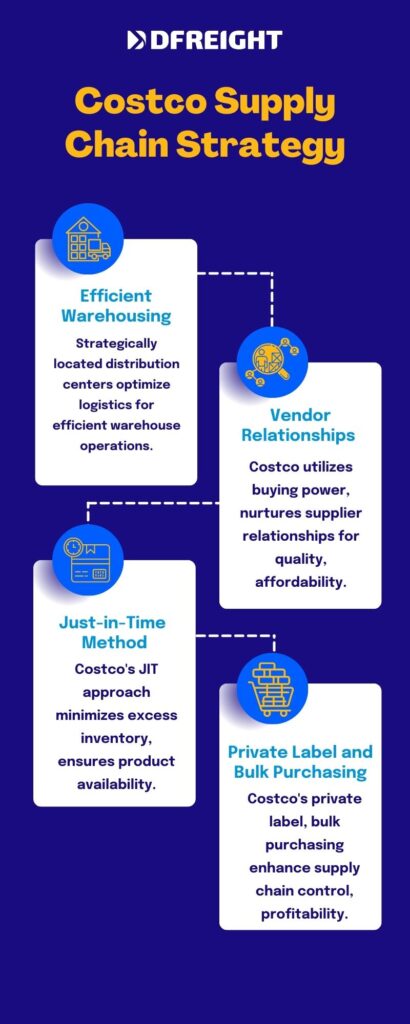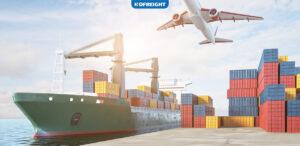Supply chain management plays a crucial role in the success of any retail business, and Costco Wholesale Corporation is no exception. With its reputation for offering high-quality products at competitive prices, Costco has become a leading warehouse club retailer globally. In this blog post, we will explore Costco supply chain and how it contributes to the company’s operational efficiency and customer satisfaction.
Ready to streamline your shipping process? Experience the future of logistics with DFreight, your trusted digital freight forwarder. Take the hassle out of shipping and unlock a world of convenience and efficiency. Request a quote today and discover the power of seamless logistics solutions with DFreight.
Table of Contents
Overview of Costco
Costco, founded in 1983 in Seattle, Washington, is a membership-based retail giant that operates a chain of warehouse clubs. It has established a strong presence in the United States and expanded its operations internationally, with warehouses in countries like Canada, Mexico, the United Kingdom, Japan, and Australia, among others. The company follows a unique business model that emphasizes providing customers with quality products in bulk at wholesale prices.
Costco offers a wide range of products, including groceries, electronics, appliances, furniture, clothing, and more. The company’s membership model allows customers to access exclusive deals, discounts, and additional benefits, fostering customer loyalty and repeat business.
Importance of Supply Chain Management
Supply chain management is the coordination and optimization of various activities involved in delivering products or services to customers. It encompasses sourcing, procurement, production, warehousing, transportation, and distribution, among other essential processes. Effective supply chain management enables companies to meet customer demands efficiently, reduce costs, and gain a competitive advantage.
In the context of Costco, supply chain management plays a pivotal role in ensuring the availability of products at competitive prices while maintaining high quality. The company’s focus on streamlining its supply chain operations has allowed it to deliver value to its members consistently. By optimizing its supply chain, Costco can pass on cost savings to customers, ensuring that they receive products at lower prices compared to traditional retailers.
Additionally, Costco supply chain management practices contribute to its reputation for excellence in customer service. Efficient inventory management, streamlined warehousing and distribution, and prompt order fulfillment ensure that customers can find the products they need readily available. By ensuring consistent product availability and efficient operations, Costco enhances customer satisfaction and customer loyalty.
Costco’s commitment to supply chain management extends beyond customer satisfaction. The company emphasizes building long-term relationships with suppliers and investing in sustainable practices. By working closely with suppliers and leveraging their buying power, Costco negotiates favorable pricing and ensures the quality and reliability of its products.
In the following sections, we will delve deeper into the specific strategies and practices that Costco employs to manage its supply chain efficiently and successfully meet the needs of its customers.
Costco Supply Chain Strategy
Costco supply chain strategy is a key driver of its operational efficiency and ability to offer competitive prices to its members. By implementing various strategies and best practices, the company ensures streamlined processes from procurement to distribution. Let’s explore some key elements of Costco supply chain strategy:

Efficient Warehousing and Distribution Centers
One of the cornerstones of Costco supply chain strategy is its efficient warehousing and distribution network. The company operates large-scale distribution centers strategically located to serve its warehouse clubs effectively. These distribution centers are designed for optimal layout and efficiency, enabling seamless inbound and outbound logistics.
Costco’s warehouses are known for their spaciousness and organized layout, allowing for easy movement of goods and efficient order picking. The company focuses on maintaining a lean inventory system, ensuring that products are quickly replenished to meet customer demands.
Vendor Relationships and Buying Power
Costco leverages its strong buying power and maintains mutually beneficial relationships with suppliers to negotiate favorable pricing and secure high-quality products. The company carefully selects suppliers based on strict criteria, including quality, reliability, and cost-effectiveness.
By establishing long-term relationships with suppliers, Costco builds trust and ensures a steady supply of goods. This partnership approach allows suppliers to align their production and inventory management with Costco’s needs, facilitating efficient replenishment and reducing lead times.
Just-in-Time Inventory Management
Costco adopts a just-in-time (JIT) inventory management approach, which minimizes excess inventory and reduces carrying costs. JIT allows the company to keep inventory levels low while maintaining high product availability. The company closely monitors sales data and adjusts its replenishment schedules accordingly, ensuring that products arrive at warehouses just in time to meet customer demand.
This JIT inventory management system helps Costco reduce warehousing space requirements, lower holding costs, and minimize the risk of inventory obsolescence. Additionally, it enables the company to respond quickly to changing market demands and optimize its inventory turnover rate.
Private Label and Bulk Purchasing
Costco’s private label strategy and bulk purchasing model are integral to its supply chain strategy. The company offers a range of private-label products under its Kirkland Signature brand, which provides quality and value to its members. By manufacturing its own products, Costco gains greater control over the supply chain, reduces dependency on external suppliers, and enhances its profit margins.
Furthermore, Costco’s bulk purchasing model allows it to negotiate better pricing with suppliers and pass on cost savings to customers. Buying products in large quantities enables the company to benefit from economies of scale, lowering the per-unit cost and offering members substantial savings.
By strategically implementing these supply chain strategies, Costco effectively manages its inventory, reduces costs, and ensures an efficient flow of products from suppliers to warehouses, ultimately delivering value to its members. In the following sections, we will explore additional aspects of Costco supply chain, including supplier selection and management, warehousing and distribution, inventory management, and technology-driven innovations.
In the previous blogs, we looked into the supply chains of famous and leading companies, which you can read about each of them in the section below.
| Amazon | McDonald |
| Adidas | Zara |
| Nike | Cisco |
| IKEA | H&M |
| Nestlé | BMW |
| Coca-Cola | KFC |
| Samsung | L’Oréal |
| ADNOC | Honda |
| Pepsi | Apple |
| Unilever | Intel |
| Schneider Electric | Starbucks |
| Tesla | Walmart |
| Toyota |
Costco’s Supplier Selection and Management
Costco places great importance on its supplier selection and management processes as a part of its overall supply chain strategy. By carefully choosing suppliers and fostering long-term relationships with them, the company ensures the availability of high-quality products at competitive prices. Let’s explore the key aspects of Costco’s supplier selection and management:
Criteria for Supplier Selection
Costco follows a rigorous selection process when choosing suppliers to partner with. The company considers several criteria to ensure that suppliers meet its standards and align with its values. Some key criteria for supplier selection at Costco include:
- Quality: Suppliers must meet stringent quality standards to ensure that the products they provide meet or exceed customer expectations.
- Cost-effectiveness: Costco seeks suppliers who can offer competitive pricing, allowing the company to pass on savings to its members.
- Reliability: Suppliers must have a proven track record of delivering products on time and in the quantities requested.
- Social and Environmental Responsibility: Costco values suppliers who demonstrate responsible business practices, including adherence to ethical standards, environmental sustainability, and fair labor practices.
- Capacity and Scalability: Suppliers should have the ability to scale their operations to meet Costco’s demand as the company continues to grow.
Long-Term Relationships with Suppliers
Once selected, Costco emphasizes building long-term relationships with its suppliers. The company values stability and consistency in its supply chain, and establishing trust and collaboration with suppliers is a crucial part of achieving this.
Costco invests time and effort in cultivating strong relationships with its suppliers. By fostering open communication and transparency, the company and its suppliers can work together to address challenges, identify opportunities for improvement, and align their strategies. Long-term relationships also enable suppliers to understand Costco’s requirements better and adapt their processes accordingly, leading to smoother operations and improved supply chain efficiency.
Supplier Performance Monitoring
To ensure that suppliers consistently meet Costco’s standards, the company conducts regular performance monitoring and evaluation. Supplier performance is assessed based on various factors, including product quality, delivery reliability, responsiveness, and adherence to agreed-upon terms and conditions.
Costco utilizes key performance indicators (KPIs) to measure supplier performance objectively. These KPIs may include metrics such as on-time delivery rate, product defect rate, customer complaints, and responsiveness to inquiries and issues. By monitoring supplier performance, Costco can identify areas for improvement and take proactive steps to address any concerns promptly.
Supplier performance monitoring also serves as a basis for ongoing supplier development and collaboration. By sharing performance data and working closely with suppliers, Costco can foster a culture of continuous improvement and support suppliers in enhancing their own operations.
Through its careful supplier selection, long-term relationship building, and diligent performance monitoring, Costco maintains a robust supplier base that supports its supply chain goals. These practices contribute to the company’s ability to consistently provide high-quality products to its members while maintaining competitive pricing.
Warehousing and Distribution
Efficient warehousing and distribution operations are critical components of Costco supply chain strategy. The company places a strong emphasis on optimizing warehouse layout, implementing advanced inventory management systems, utilizing cross-docking operations, and ensuring smooth transportation and logistics. Let’s explore these aspects in more detail:
Warehouse Layout and Design
Costco pays careful attention to warehouse layout and design to maximize efficiency and productivity. The company’s warehouses are designed with spacious layouts and clear organization, allowing for the smooth movement of goods and streamlined order fulfillment processes.
The layout incorporates designated areas for receiving, storage, picking, packing, and shipping operations. Efficient product placement and well-defined aisles enable quick and easy access to products, minimizing the time required for order picking and replenishment. This well-designed layout helps reduce handling costs, improve inventory accuracy, and enhance overall operational efficiency.
Inventory Management Systems
Costco relies on sophisticated inventory management systems to effectively track and control its vast product inventory. These systems provide real-time visibility into inventory levels, enabling accurate demand forecasting and optimal inventory replenishment decisions.
By utilizing advanced technologies such as barcode scanning, radio frequency identification (RFID), and automated data capture, Costco ensures accurate inventory counts and efficient inventory movement. The systems facilitate accurate order fulfillment, reduce the risk of stockouts, and enable timely replenishment to meet customer demands.
Additionally, inventory management systems at Costco support inventory optimization techniques such as safety stock management, economic order quantity (EOQ) calculations, and inventory turnover analysis. These practices help minimize excess inventory, reduce carrying costs, and maintain optimal stock levels throughout the supply chain.
Cross-Docking Operations
Cross-docking is an important practice employed by Costco to streamline its distribution operations. Cross-docking involves transferring products directly from inbound shipments to outbound transportation, bypassing the need for long-term storage in the warehouse.
Costco’s cross-docking operations enable the rapid movement of goods from suppliers to stores, reducing inventory holding times and associated costs. This practice is particularly effective for perishable goods and fast-moving consumer products, allowing for faster turnaround times and fresher products for customers.
By leveraging cross-docking, Costco minimizes handling and storage costs, reduces the risk of inventory obsolescence, and improves overall supply chain efficiency.
Transportation and Logistics
Costco places a strong emphasis on efficient transportation and logistics to ensure the timely delivery of products to its warehouses and stores. The company works with a network of transportation partners and carriers to optimize transportation routes, minimize transit times, and reduce transportation costs.
By leveraging its volume and buying power, Costco negotiates favorable shipping rates with logistics providers. The company’s large order quantities and consolidated shipments allow for efficient use of transportation resources, reducing carbon emissions and promoting sustainability.
Furthermore, Costco invests in advanced tracking and tracing technologies to monitor the movement of goods throughout the transportation process. This enables real-time visibility into shipments, allowing for proactive management of potential delays or disruptions.
Efficient transportation and logistics operations enable Costco to maintain a reliable and responsive supply chain, ensuring that products reach their destinations promptly and efficiently.
By focusing on warehouse layout and design, implementing advanced inventory management systems, utilizing cross-docking operations, and optimizing transportation and logistics, Costco enhances its overall supply chain efficiency and customer satisfaction. These practices contribute to the company’s ability to provide a wide range of quality products to its members in a cost-effective manner.
Inventory Management
Inventory management is a critical aspect of Costco supply chain strategy. The company employs various practices to ensure efficient inventory management, accurate demand forecasting, timely replenishment, and effective tracking and control of inventory. Let’s explore these key elements in detail:
Demand Forecasting and Planning
Accurate demand forecasting is crucial for Costco to optimize inventory levels and meet customer demands effectively. Costco leverages historical sales data, market trends, and customer insights to forecast future demand patterns. The company analyzes sales data at both the warehouse and product level to identify demand fluctuations and seasonal trends.
By using sophisticated demand forecasting techniques, Costco can predict customer demand with a high level of accuracy. This allows the company to align its inventory levels, production schedules, and replenishment activities accordingly. Accurate demand forecasting helps reduce the risk of stockouts and overstock situations, ensuring that the right products are available at the right time.
Efficient Replenishment Systems
Costco employs efficient replenishment systems to ensure that products are replenished promptly and in the appropriate quantities. The company closely monitors inventory levels and sales data to trigger replenishment orders proactively.
By using advanced inventory management systems, Costco automates the replenishment process, eliminating manual intervention and reducing the chances of human errors. The systems generate replenishment orders based on predefined reorder points, safety stock levels, and demand forecasts.
Efficient replenishment systems enable Costco to maintain optimal inventory levels, minimize stockouts, and reduce excess inventory holding costs.
Safety Stock and Inventory Optimization
To mitigate the risks associated with uncertain demand patterns and supply chain disruptions, Costco employs safety stock and inventory optimization techniques. Safety stock is an additional stock buffer maintained above the expected demand to accommodate unforeseen variations in demand or supply lead times.
By calculating safety stock levels based on historical demand variability and lead time variability, Costco ensures a buffer against unexpected fluctuations. This helps to reduce the risk of stockouts and maintain high service levels to customers.
Costco also focuses on inventory optimization techniques to balance inventory levels and cost efficiency. By analyzing inventory turnover rates, economic order quantities, and carrying costs, the company optimizes inventory levels to strike the right balance between product availability and cost containment.
Inventory Tracking and Control
Effective inventory tracking and control are essential to ensure accurate inventory records and minimize discrepancies. Costco utilizes barcode scanning, RFID technology, and automated data capture systems to track inventory movement throughout its supply chain.
By scanning barcodes or using RFID tags, Costco can accurately track the movement of products from suppliers to warehouses and from warehouses to stores. This real-time visibility enables better control over inventory levels, reduces the risk of shrinkage or loss, and facilitates timely replenishment.
Inventory control practices, such as cycle counting and regular physical inventory audits, are also implemented to ensure inventory accuracy and identify any discrepancies between physical counts and system records.
Through efficient demand forecasting and planning, streamlined replenishment systems, safety stock optimization, and robust inventory tracking and control, Costco effectively manages its inventory to meet customer demands while minimizing costs and maintaining high service levels.
These inventory management practices contribute to Costco’s ability to provide a wide variety of products to its members, ensuring product availability and customer satisfaction across its warehouse club locations.
Technology and Innovation in Costco Supply Chain
Costco recognizes the importance of technology and innovation in driving operational efficiency and staying competitive in the rapidly evolving retail industry. The company adopts various technological advancements and innovative practices within its supply chain to enhance visibility, optimize processes, and promote sustainability. Let’s delve into the key areas of technology and innovation in Costco supply chain:
RFID and Barcode Systems
Costco utilizes RFID (Radio Frequency Identification) and barcode systems to enhance inventory tracking and management. RFID tags and barcode labels are attached to products, enabling automated identification and tracking throughout the supply chain.
RFID systems provide real-time visibility into the movement of products, allowing for accurate inventory counts, improved order accuracy, and reduced out-of-stock situations. Barcode systems enable efficient scanning and tracking of products at various stages, ensuring inventory accuracy and streamlined order processing.
By leveraging RFID and barcode systems, Costco improves inventory visibility, minimizes errors, and enhances supply chain efficiency.
Data Analytics and Predictive Analytics
Data analytics plays a crucial role in Costco supply chain strategy. The company leverages data from various sources, including sales data, customer behavior data, and supply chain data, to gain insights and make informed decisions.
Costco utilizes advanced analytics techniques, such as predictive analytics, to forecast demand, identify trends, and optimize inventory levels. By analyzing historical data, market trends, and external factors, Costco can accurately predict future demand patterns, optimize product assortments, and plan inventory replenishment activities.
Data analytics also helps Costco identify areas for process improvement, optimize transportation routes, and enhance overall supply chain performance.
Automation and Robotics
Automation and robotics are key components of Costco supply chain innovation. The company employs automated systems and robotic technologies to streamline various processes, improve efficiency, and reduce manual labor requirements.
In warehouses and distribution centers, automated systems facilitate order picking, sorting, and packing operations, reducing errors and improving throughput. Robotics technology, such as automated guided vehicles (AGVs), assists in material handling and inventory movement, enabling efficient warehouse operations.
Automation and robotics help Costco achieve higher productivity, faster order processing, and increased accuracy in its supply chain operations.
Sustainability Initiatives
Costco is committed to sustainability and incorporates environmentally friendly practices within its supply chain. The company focuses on reducing its carbon footprint, minimizing waste, and promoting sustainable sourcing and operations.
In transportation and logistics, Costco explores alternative fuel options, optimizes transportation routes, and collaborates with carriers to reduce emissions and promote greener practices. The company also emphasizes packaging optimization to minimize waste and promotes recycling initiatives throughout its supply chain.
Furthermore, Costco actively engages with suppliers to ensure responsible sourcing practices, including sustainable agriculture, fair labor practices, and ethical standards.
By integrating sustainability initiatives into its supply chain, Costco demonstrates its commitment to environmental stewardship and responsible business practices.
When it comes to sustainability and efficiency, DFreight focuses on using green methods and the latest technology to reduce its impact on the environment and make its processes smoother.
Through adopting RFID and barcode systems, data analytics, automation, robotics, and sustainability initiatives, Costco leverages technology and innovation to optimize its supply chain operations. These practices enable the company to enhance efficiency, improve customer service, and promote sustainable business practices, ultimately driving its continued success in the retail industry.
Wrap-up
In conclusion, Costco supply chain stands as a testament to the company’s commitment to operational excellence, customer satisfaction, and responsible business practices. By continuously refining its processes, embracing technological advancements, and prioritizing sustainability, Costco has established itself as a leader in the retail industry, consistently meeting the needs of its members and delivering value through its efficient and effective supply chain.
How does Costco manage its vast product inventory efficiently?
Costco employs advanced inventory management systems, demand forecasting techniques, and optimized replenishment processes to ensure efficient management of its extensive product inventory.
What steps does Costco take to maintain strong relationships with its suppliers?
Costco focuses on long-term relationships with suppliers, emphasizing criteria such as product quality, reliability, and ethical sourcing practices. Regular performance monitoring and collaboration contribute to strong supplier partnerships.
How does Costco ensure the smooth flow of goods through its warehousing and distribution centers?
Costco designs its warehouses with efficient layouts and utilizes inventory management systems for the seamless movement of goods. Cross-docking operations and streamlined transportation logistics also contribute to the smooth flow of products.
What role does technology play in Costco supply chain operations?
Technology plays a vital role in Costco supply chain, with RFID and barcode systems enabling accurate inventory tracking. Data analytics, automation, and robotics further enhance visibility, efficiency, and productivity within the supply chain.
How does Costco integrate sustainability into its supply chain practices?
Costco implements sustainability initiatives by optimizing transportation routes, exploring alternative fuels, minimizing packaging waste, and promoting responsible sourcing practices. The company aims to reduce its environmental footprint and support sustainable business practices.














